Hygrophila species
Contents:
- Re:Hygrophila and Synnema symptoms
by krombhol-at-felix.TECLink.Net (Paul Krombholz) (Tue, 26 Sep 1995)
- re: Hygrophila difformis
by "David W. Webb" <dwebb-at-ti.com> (Thu, 1 Feb 1996)
- Sunset Hygo
by nfrank-at-nando.net (Neil Frank) (Sat, 17 Feb 96)
- Aquatic Plants Digest V2 #35
by krombhol-at-felix.TECLink.Net (Paul Krombholz) (Sat, 27 Apr 1996)
- Creeping Plants
by Bruce Towle <btowle/pacifier.com> (Sat, 08 Nov 1997)
- Hygrophila ID
by krandall/world.std.com (Wed, 14 Oct 1998)
- RE: Roots on stem plants
by Mark Fisher <Mark.Fisher/tpwd.state.tx.us> (Wed, 2 Dec 1998)
- Hygrophila difformis
by krandall/world.std.com (Tue, 02 Feb 1999)
- H difformis
by krandall/world.std.com (Tue, 09 Feb 1999)
- Hygrophila polysperma banned in CA
by "Rubin, Michael" <mrubin/visa.com> (Fri, 15 Oct 1999)
- Aquatic Plants Digest V3 #1329
by Chuck Gadd <cgadd/cfxc.com> (Fri, 15 Oct 1999)
- Nomaphila corymbosa 'compacta' questions
by "James Purchase" <jppurchase/rogers.com> (Wed, 13 Feb 2002)
|
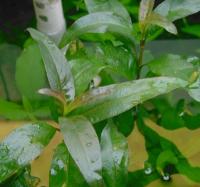
Hygrophila stricta/corymbosa,
showing emersed leaves.
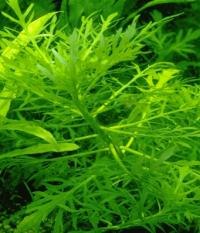
Hygrophila difformis (wisteria)
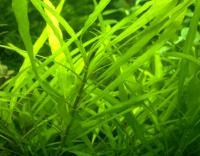
Narrow-leafed Hygrophila
Photos and video still by Erik Olson
|
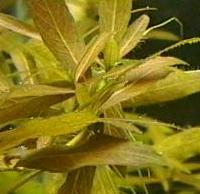
Hygrophila polysperma
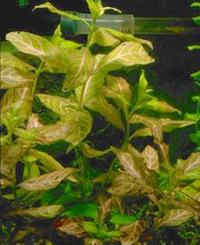
Hygrophila polysperma ``sunset''
Photos and video still by Erik Olson
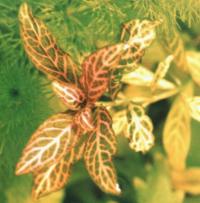
H. polysperma "sunset", top view
|
by krombhol-at-felix.TECLink.Net (Paul Krombholz)
Date: Tue, 26 Sep 1995
- ------------------------------
>
>From: Plants FIDO-Gate <Plants.FIDO-Gate-at-f78.n480.z2.fidonet.org>
>Date: Mon, 25 Sep 95 22:01:04 +0100
>Subject: Some kind of a defficiency
>
>All!
>
>I seem to have a little problem in mi goldfish tank
>concerning some kind of a defficiency. Here are the
>symptoms:
>
>Some of my Hygrophila and Synnema plant leaves seem to have
>the outside a bit yellowish, while the inside of the leaf is
>still grean. Also on some of the leaves there seem to be
>skirt cut-like marks (transparent short lines across the
>leaf surface in different directions). What kind of a
>defficiency can that be and what can I do to fix it?
>
I don't know about the yellow borders, but the transparent tissue you
mention in the leaves is a sign that the plants are getting continuous
light. I have seen, only in the Hygrophila genus (which now includes
Synnema) that if the plants are given continuous light, they produce small,
distorted leaves that have transparent tissue, i.e. no air space in the
leaves. Are you, by chance, giving the plants continuous light or,
perhaps, very short nights?
Paul Krombholz Tougaloo College, Tougaloo, MS 39174
by "David W. Webb" <dwebb-at-ti.com>
Date: Thu, 1 Feb 1996
>Anyways, I'm looking to grow this type of plant, in a planted aquarium
>set-up. Before I get the old 30 gallon tank going, I'd like to hear
>from those out there who have had success with this plant. Also, what
>other plants go along with hygrophila difformis? What fish for that matter.
H. difformis (water wisteria) is a very non-demanding plant. It will grow both
emersed and submersed, although it prefers a pretty high humidity environment
when grown emersed. No particular substrate needs (it will grow in a floating
bunch, but it is a stem plant and does not behave like Indian fern or Water
sprite, and it doesn't require a lot of iron. This plant prefers moderate to
high light and will go nuts over CO2 injection or if grown emersed. In very
high light, it will send horizontal stems across the bottom of the tank. If
you have a waterborne nutrient problem, this plant is difficult to clean algae
off of because the leaves break relatively easily, although it's less brittle
than h. polysperma.
If your nutrient level drops completely to zero, the plant will just stop
growing. Emersed growth does not do well when submersed, and vice-versa. It
is capable of sending out rootlets from each leaf node, whether grown emersed
or submersed. It kinda looks strange in my micro tank with airborne roots.
Underwater, the roots become relatively fine and branch out. In a substrate
with mulm, the roots become very fine and resemble the "Crystalline Entity"
from Star Trek in color and pattern.
I've kept it with a strain of h. polysperma that has a pinkish cast to the
leaves (not alternathera), rotala indica, anubuas nana, java fern, java moss,
bolbitis heudetrollis, v. spiralis, c. wendtii, and probably some others that
slip my mind without problem.
David W. Webb
Enterprise Computing Provisioning
Texas Instruments Inc. Dallas, TX USA
(214) 575-3443 (voice) MSGID: DAWB
by nfrank-at-nando.net (Neil Frank)
Date: Sat, 17 Feb 96
>Sounds like H. polysperma 'Tropical Sunset'. I believe this was
>developed at Tropica in Denmark, but is now grown extensively in
>Florida.
Karen: This plant was independently 'developed' in the U.S. I saw it at a
Nursery in Florida during the late 1980's, at which time the U.S. grower was
obtaining a patent. I mentioned this to Claus Christensen of Tropica and he
conceded that coincidences do occur. <g>
All H. polysperma are considered to be noxious weed in some South Eastern
States and for example, is not supposed to be shipped to or sold in NC.
I have found that sunset does not grow as fast as 'regular' H. polysperma. I
put regular in quotes because the Dennerle plant catalog (available to AGA
members <g>) shows pictures of 3 varieties besides the sunset:
(1)H polysperma (dwarf hygo, from India) - pale green
(2)H. polysperma, "Golden-Brown" - (presumably from SE Asia) - upper leaves
have the different color
(3) H. polysperma var CEYLON (discovered in 1980 in Sri Lanka) -longer more
slender leaves.
I have no. (2)
Neil Frank Aquatic Gardeners Association, Raleigh NC
by krombhol-at-felix.TECLink.Net (Paul Krombholz)
Date: Sat, 27 Apr 1996
Paul Rothel <prothel-at-bright.net> said, Apr. 26:
>
.................I use my Hygro as sort of the canary in my tank. If that
>particular plant isn't growing substantially each day, something is wrong.
>...................
It was a pleasant surprise to see this statement. I use Hygrophila
polysperma the same way. It is a great indicator plant because it grows
rapidly when conditions are good and its variations in leaf size, shape and
angle with the stem can tell a lot about how good the light, nutrients, and
CO2 levels are. However, it can take over the tank quickly if not regularly
and severely pruned. It is also a very good plant to get started in a
newly set up tank.
Paul Krombholz Tougaloo College, Tougaloo, MS 39174
by Bruce Towle <btowle/pacifier.com>
Date: Sat, 08 Nov 1997
Newsgroup: rec.aquaria.freshwater.plants
Jennifer Koopmansflyer-at- wrote:
>
> I've been reading the newsgroup for a while and was wanting some input. I
> have a
> 77 gal. tank with 160 watts of Chroma 50 over the top. The problem is my
> H.polysperma and Ludwigia are creeping across the bottom. They have a nice
> red color and appear healthy. Is this too much light or not enough? It's
> been suggested there's enough light, if that's the case, how can I get them
> to grow up? Plant them closer together? Any suggestions would be
> appreciated.
I have both of these plants in tanks with about 4watts/gal of light. As
soon as I added the additional light, both plants started growing as you
described if there was an open area.
They grow horizontal and will root at each node. Then a riser
(vertical) will start growing from the node. With H. polysperma, I
actually have a carpet of it since I keep trimming it to 2-3 inches in
height.
When they (the horizontal part) runs into another plant, it will start
growing vertical. They will actually will get very thick and will start
growing massive root systems that will soon create an impenetrable mass
of vegetation. In my 90 gal, tank the H.polysperma got so matted that
my pleco would hit it head on and try to power his was throught it. He
would eventually give up and go under or around.
--
Bruce Towle
btowle-at-pacifier.com
by krandall/world.std.com
Date: Wed, 14 Oct 1998
>>>I have two plants in my 50g tank that are supposed to be
>>>Hygrophila/Nomaphila? stricta/corymbosa? I will like to know what are
>>>they, here is a briefly description of each one.
>>
>>I think you are correct. The first is H. cormybosa and the second,
>>Nomaphila stricta. That's how I label them. The former did not grow
>>well for me; the latter does very well. To myself, a non-botanist,
>>they appear quite dissimilar.
>>
>Thank you Dave for answering my post. If there anyone else that have some
comments about this. I4m curious why the books and other refer to this
plants as the same since they are so different.
Current thinking is that both of these plants are H. corymbosa.
We tend to expect every plant of a speices to look like every other plant
of a species. We don't expect that of people. Much of the plant material
that is available commercially is propagated vegetatively, and therefore is
basically all the same plant. When you have plants that are propagated
sexually, there is _much_ greater variation between specimens. One only
has to visit New England in the fall and see the amazing variation of
asters (all one species) to see this. There are tall pale ones, short
bright purple ones, ones that sprawl and others that grow in compact
mounds. This is also the reason that most gardeners pull volunteer phlox
seedlings... They might be pretty, but they are probabaly not the same as
the near by parent that produced the seed.
There are a number of different varieties and cultivars of H. corymbosa, as
well as a number of crosses available on the market.
Karen Randall
Aquatic Gardeners Association
by Mark Fisher <Mark.Fisher/tpwd.state.tx.us>
Date: Wed, 2 Dec 1998
> What causes plants like Hygrophilia, Cabomba and others to
> produce roots on the stem above the substrate? I'd like to stop it,
if I can.
> Gets a little messy and annoying.
I've seen Hygrophila "creeping" along the bottom in the swift current of
the San Marcos river (i.e., growing horizontally). The roots from the
nodes help anchor the horizontal stem to the substrate. Otherwise, the
current would beat the plant to death. I don't know if this is the
specific purpose of the nodal roots, but it is certainly effective.
I don't think you can stop it.
Regards,
Mark
by krandall/world.std.com
Date: Tue, 02 Feb 1999
>A couple of questions for Karen:
>
>How do you keep H.difformis form start growing bigger once it have root on
the gravel. Wouldn't they start growing new plants from the nodes?
>
>Also how can H.difformis be prunned to mantain a medium size because they
keep growing and sending bigger and bigger stems.
H. difformis is _not_ a low maintenance ground cover simply because it does
grow so fast. It must be cut back hard quite regularly. But it tolerates
this quite well, becoming bushier and bushier.
Karen Randall
Aquatic Gardeners Association
by krandall/world.std.com
Date: Tue, 09 Feb 1999
> So far this has worked great, but I was wondering what Karen meant
>by "mowing it down". I have never had H. difformis get bushier after being
>trimmed. It just puts out another shoot and continues on it's merry way.
Many stem plants, H difformis included, will begin to branch at the node
just below a cut. If the nodes are all at ground level, as they are when
you are keeping H. difformis low, you get more and more branches, shoots or
what ever you choose to call them. That makes for a "bushier" ground cover.
But if you don't keep on top of it, it will send those shoots right back up
to the surface.
Karen
by "Rubin, Michael" <mrubin/visa.com>
Date: Fri, 15 Oct 1999
Eric wrote:
> Yesterday, the LFS told me they couldn't sell H. polysperma any
> more because it was banned in California a month ago after it
> choked everything else out in a lake somewhere. This was the first
> I'd heard of this; has anyone else heard it?
Neil Frank, editor of The Aquatic Gardener magazine, mentioned this when he
visited the SF Bay Area Aquatic Plant Society a couple of months ago,
surprising the entire group of us. Apparently it's true.
- --------------------------------
michael rubin
mrubin@visa.com
1(650) 432-4685
by Chuck Gadd <cgadd/cfxc.com>
Date: Fri, 15 Oct 1999
> Date: Thu, 14 Oct 1999 15:18:17 -0700 (PDT)
> From: eric@alchemy.cchem.berkeley.edu (Eric Tulsky)
> Subject: Hygrophila polysperma banned in CA?
>
> Yesterday, the LFS told me they couldn't sell H. polysperma any
> more because it was banned in California a month ago after it
> choked everything else out in a lake somewhere. This was the first
> I'd heard of this; has anyone else heard it?
>
According to the arizona aquatic gardens website, several common aquatic
plants were recently banned:
ATTN: THE U.S.D.A. HAS ISSUED THIS PLANT TO BE A NOXIOUS WEED AND IS NO
LONGER SHIPPABLE INTO ANY STATE FROM ANYWHERE FROM ANY SUPPLIER LEGALLY.
Asian Ambulia (Limnophilia sessiliflora)
Hygrophila, Green (Hygrophila polysperma)
Hygrophila, Tropic Sunset (Hygrophila rosanervis)
I am curious if it's legal to trade this inside state borders?
by "James Purchase" <jppurchase/rogers.com>
Date: Wed, 13 Feb 2002
Naomi wrote:
"...In the store, they were labelled
"Nomaphila corymbosa 'compacta'." I've been told that "Nomaphila" is just
another name for "Hygrophila"; I think the reason why this store uses the
former nomenclature is to avoid hassles with the Dept. of Agriculture. Most
of the Hygrophila spp are banned, here, and I'm sure just having the genus
name on the packing list would be enough to send up a red flag."
Interesting conjecture, and it might be the case. It would be one way to get
a banned plant past a lax inspector. However, there is some "official"
support for the use of the name. Christopher D.K. Cook, in his Aquatic
Plant Book (the source that Tropica uses for their plant nomenclature) says
that the genus Hygrophila, as currently used, encompases the genera
Asteracantha, Cardanthera, Nomaphila and Synnema. He also satates that the
generic delimination of the tribe (taxonomic category between the family and
genus level) Hygrophileae is "much in need of revision".
The generic name Nomaphila was first used by Carl Ludwig von Blume (Blume)
in 1826, while the generic name Hygrophila was first published in 1810 by
the botanist Robert Brown (R.Br.). The species "corymbosa" has been
described under both generic names (Hygrophila and Nomaphila) - Blume
described "Nomaphila corymbosa" in 1826 and Gustav Lindau (Lindau) described
Hygrophila corymbosa (date unknown). According to the "rules" which govern
such things, when there are two (or more) generic names used to describe the
same plant, priority is given to the one which was published first - in this
case, Hygrophila (1810) takes priority over Nomaphila (1826). The same
situation exists when a later revision of a group of genera result in
several genera being grouped together under a single generic name - the
oldest validly published name becomes the "accepted" name for the whole
group.
It also helps to keep in mind that, at least in a lot of cases, the exact
placement of any species is just an "opinion" and is what one (or more)
botanists thought at a particular point in time, given their experience and
research. Later workers, with different information, might place a plant in
a different classification. Very little is set in stone. This situation
mirrors the one discussed earlier in the month regarding the genera
Eusteralis and Pogostemon.
Hygrophila species are usually emergent aquatics - they grow rooted in wet
soil and they can have leaves both above and below the waterline. In many
cases, the size and shape of the leaves will differ, depending upon whether
they are emersed or submerged. The inflorescence in H. corymbosa could be
what you are describing - the flowers grow from the point where the leaves
meet the stem, and they appear in groups. These could appear to be what you
call "tubers". Every Hygrophila species I have ever grown has been readily
rooted from cuttings, so I don't think that you would hurt anything to just
lop off the healthy top of your plants and stick them into the substrate.
Don't discard the remaining "stem" - leave it alone and you might see
dormant buds in the leaf axils start to grow, giving you more potential
cuttings to increase your stock.
When you look at a plant name and see a third name (i.e H. corymbosa
'compacta'), usually enclosed in parenthesis or sometimes capitalized
following the species epithet, it usually indicates a cultivated variety. If
it appears without any emphasis, it would mean a natural sub-species. In
this case, 'compacta' would mean a cultivated variety of H. corymbosa which
is physically smaller than the natural form. Looking at the Tropica
listings - you quite often see plant names which have three words - this
just means that a lot of what they are selling are cultivated variants of
the natural forms (and this is a good thing - it means that the nurseries
are working to select and improve the plants that they sell).
James Purchase
Toronto